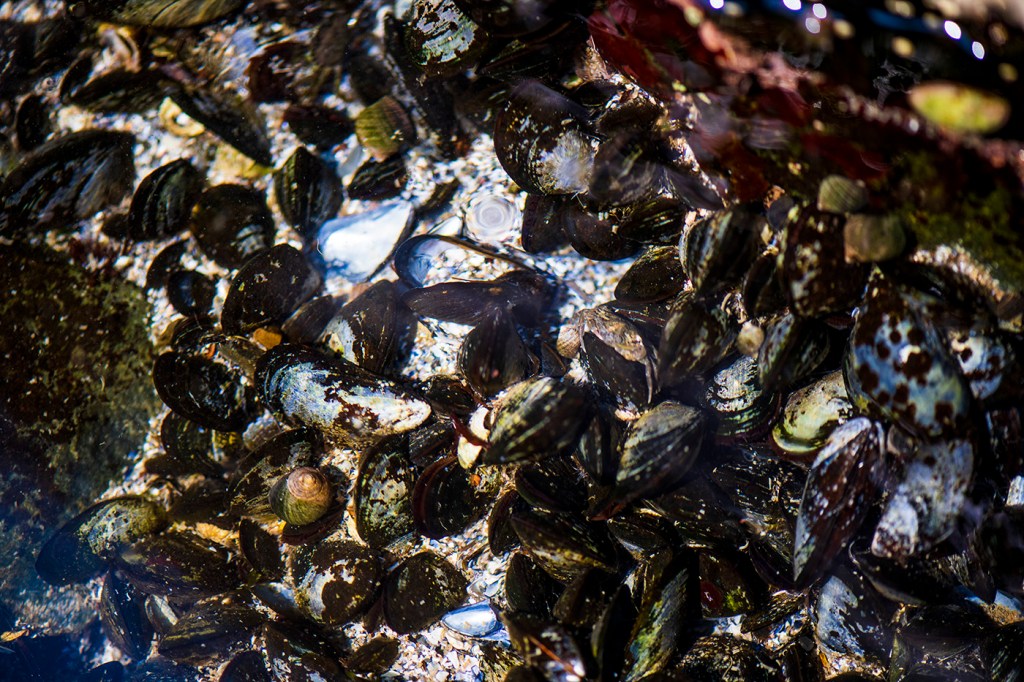Climate Change Could Destroy 95% of Surface Ocean Conditions

The vast majority of the world’s oceans may never be the same if humanity doesn’t curb our carbon emissions.
As much as 95% of the climates in the surface ocean that exist today could completely disappear within 80 years, according to new research led by Katie Lotterhos, associate professor of marine and environmental sciences at Northeastern. That means that the creatures that live there could soon be subject to conditions that they have never experienced—and some of those conditions might literally erode their skeletons and shells.

Katie Lotterhos, associate professor in marine and environmental sciences at Northeastern, poses for a portrait in Nahant. Photo by Ruby Wallau/Northeastern University
The surface ocean is the swath of seawater that reaches from where air meets water down to a depth of about 330 feet. It’s a section of the seas that interacts directly with the elevated carbon dioxide levels in the atmosphere. That seawater absorbs the carbon dioxide that’s in the air until the two come into equilibrium, so the more CO2 there is in the atmosphere, the more CO2 there is in the surface ocean.
Lotterhos and her colleagues wanted to determine just how much of the global surface ocean might be altered by climate change. So they used atmospheric carbon dioxide data to model what the global ocean climates might look like by the year 2100 under two scenarios: one in which emissions peak in 2050 and then are slowed, and another scenario that is more “business-as-usual” with emissions peaking in 2100. They also worked backward and modeled how the global ocean surface climate had changed from the year 1800 to 2000. Their results were published in the journal Scientific Reports on Aug. 26.
Lotterhos was studying two different things. She was looking for points around the globe where existing conditions were at risk of disappearing entirely; and places where conditions that had never been experienced (or at least hadn’t been experienced since 1800) were currently emerging or might emerge by 2100.
Her research focused on three variables in the surface ocean to determine its climate: temperature, acidity as measured by pH, and something called “saturation state.” Saturation state is a measure of the potential for a mineral, such as calcium carbonate, to form or dissolve in seawater. Marine creatures such as oysters, snails, and corals build their shells or skeletons by drawing calcium from seawater.
“The climates that are disappearing are the climates that have these higher pH, so they’re less acidic, and have higher saturation states,” Lotterhos says. “It’s the conditions that make it easier for organisms to make their shells” that are disappearing.
But it’s not just an issue of a creature’s ability to build their bony bits. “Ocean acidification is essentially this two-sided problem,” Lotterhos says. “It makes the calcium harder to get from the seawater to make shells. And then once it becomes so extreme … the shells that they do make can actually dissolve back into seawater.”
That’s not a foregone conclusion, Lotterhos found in her research. In the models, under the more moderate scenario—the scenario under which humanity curbs carbon emissions by 2050—just about 35% of existing sea surface climates are projected to disappear and about 10% of the surface ocean climates are projected to become conditions that had not been experienced before, called “novel climates.” Under the “business-as-usual” scenario in which carbon emissions are not curbed by 2100, about 95% of existing conditions are projected to disappear and about 82% of surface ocean climates are projected to become “novel climates.”
“It is quite surprising that there is such a big difference in the projections,” Lotterhos says. “It indicates that it’s not too late. Mitigation is really important and indeed could make a big difference.”
Although the ocean surface climates are already changing a bit, Lotterhos found that in 2000 there weren’t many novel climates that didn’t exist in 1800. But, according to the models, that could all change by 2100.
“Even though we’ve seen some warming and some acidification, it’s not outside the climate envelope of what species have experienced in the last 200 years,” Lotterhos says. “It’s only over the next 80 years that we start seeing the emergence of these novel climates.”
That offers a glimmer of hope, she says.
Lotterhos adds that there are still a lot of unknowns about how ocean creatures will respond to shifts in their environments. Some might not be negatively affected, she says. Some species, such as phytoplankton, might benefit from the increased carbon dioxide because they use it to photosynthesize. Or perhaps some species will be able to evolve quickly enough to survive in these conditions.
“When we talk about climate change, there are winners and losers,” she says. “It may be detrimental to some species, we can expect to see change, but to say that all the change that we will see is going to be negative is not necessarily true.”
For media inquiries, please contact Marirose Sartoretto at m.sartoretto@northeastern.edu or 617-373-5718.





